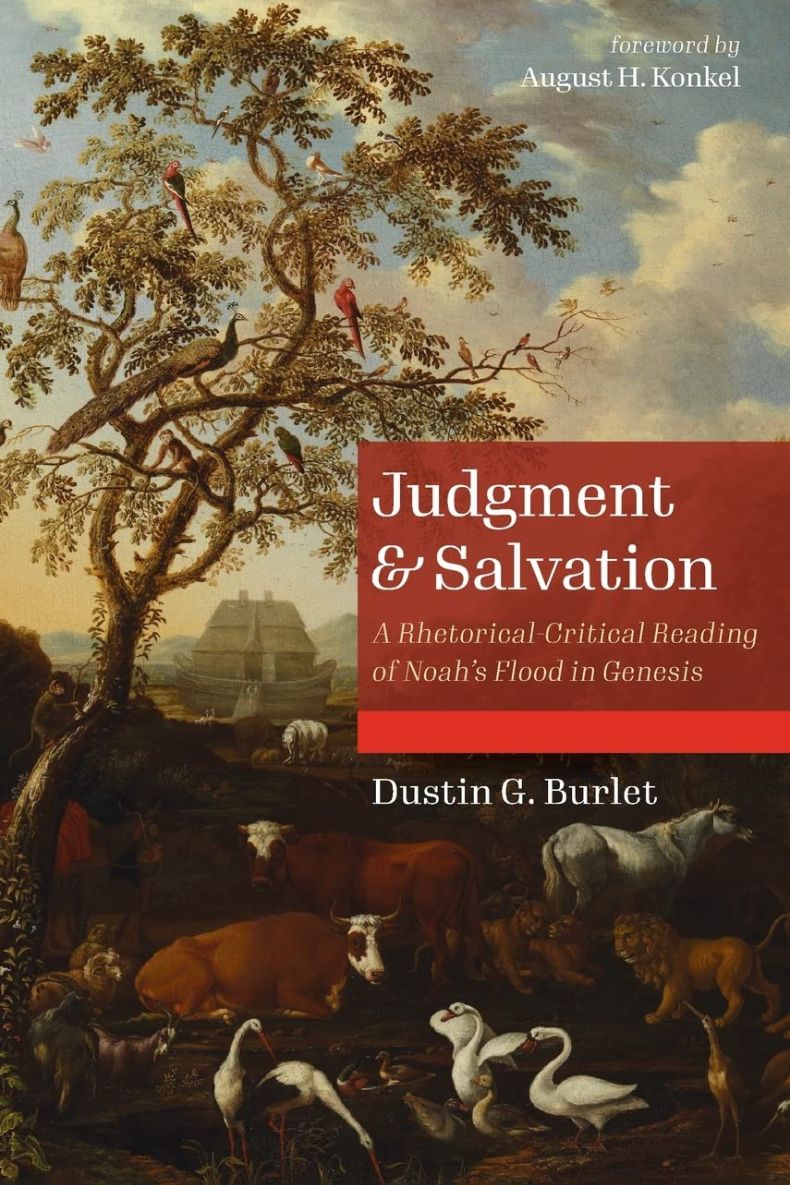Judgment & Salvation: A Rhetorical-Critical Reading of Noah’s Flood in Genesis, by Dustin G. Burlet. Eugene, OR: Pickwick, 2022. xxxv + 268 pp. $40.00.
As a corollary to debates about the age of the earth, discussions about Noah’s flood have tended to divide interpreters into rival camps. Conservative interpreters, exemplified by Answers in Genesis and the Institute for Creation Research, generally conclude that the flood was global and catastrophic. A growing segment of evangelicals, usually those who contend for an old earth, counter that a local flood comports better with the scientific evidence. One example of the latter approach is Gavin Ortlund’s popular vlog addressing the question “Was Noah’s Flood Local?” (available online at https://www.youtube.com/watch?v=Rq5tUg4SWzs, accessed 28 April 2025).
Burlet’s study of Noah’s flood does not seek to answer questions concerning the extent of the flood so much as to ascertain the intent of the flood narrative’s author. His rhetorical-critical analysis aims to fill a gap in the literature, which often focuses on Genesis as a whole or on prominent characters within its storyline (xxviii). He contends that the flood narrative underscores deliverance and salvation more than judgment and destruction and that the text focuses on God’s redemptive disposition toward his creation. God’s purposes are not thwarted in the flood; rather, God commits himself to the outworking of his intention for creation, to bless his image-bearers and to uphold the sanctity and flourishing of human life. The flood thus serves as a “re-creation event” and even as a “flood of grace” (4).
The work divides into six main chapters with a concluding seventh chapter. In the first chapter Burlet sets the background for his study, focusing on previous scholarly approaches to the flood account and its background in Genesis generally. He orients the reader to rhetorical criticism, which assesses the persuasive strategy of a text. He adapts more specifically Kennedy’s model, which evaluates the rhetorical shape and strategy of texts through five steps, determining the rhetorical boundaries, situation, form, strategy, and effectiveness (10). He then addresses interpretive questions arising from the flood account, such as the meaning of Yahweh’s response to Noah’s sacrifice after Noah emerged from the ark. He assesses also matters of literary structure, concluding that the narrative’s literary structure tells against diachronic redaction criticism and favors an integrative, synchronic reading.
Chapter two presents Burlet’s methodology. The first part assesses different tools used by scholars to identify rhetorical features in Scripture. Rhetorical criticism divides into two branches, with scholars who focus on compositional features in the production of texts (Muilenburg) and scholars who focus on argumentation and structure with a view to the text’s persuasive quality (Barker). Following Barker, Burlet argues that rhetorical criticism should analyze both the literary features of a text as well as the text’s impact on its audience (35–36). Through the rest of the chapter, he surveys Kennedy’s five steps in detail, showing how the interpreter determines the text’s boundaries, situation, genre, strategy, and persuasive effectiveness (36–82). This section offers numerous insights for careful readers of Scripture but may prove difficult for the general reader. For example, the rather fine distinctions among categories such as the real author, implied author, and narrator versus the narratee, implied reader, and real reader complicates the interpretive process.
The next four chapters offer the heart of the book, containing Burlet’s analysis of the flood narrative using Kennedy’s model. In each chapter he assesses a section of the flood narrative through four of Kennedy’s steps: determining the units, the situation, the strategy, and the effectiveness. Thus, chapter 3 analyzes Genesis 6:5–22; chapter 4, Genesis 7:1–24; chapter 5, Genesis 8:1–22; and chapter 6, Genesis 9:1–17. These chapters provide an insightful survey of the text’s literary structure and programmatic purpose. For example, he recognizes Genesis 8:1, where “God remembered Noah,” as part of “the pivot point of the narrative structure of the Noahic deluge with Gen 8:1 being the key turnaround of the entire construct” (159). These chapters cumulatively provide a student, teacher, or pastor with helpful clues to the literary features and structure that will pay dividends for understanding and teaching the passages. The concluding chapter summarizes his approach to rhetorical criticism and offers a way forward for future research, such as a greater focus on intertextuality with respect to the Noahic covenant’s role in later Scripture.
Burlet’s study is a helpful contribution to understanding aspects of the flood narrative, especially through his translation and identification of textual pericopes. The focus on rhetorical criticism equips readers with a deeper grasp of how this tool can aid in biblical exegesis. The attention to rhetorical criticism does lead, on the other hand, to shorter shrift with respect to other syntactical and theological issues. This reviewer would like to have seen, for example, a more extensive treatment of the theological implications of the Noahic covenant and its relationship to human government, the nature of the waters prevailing on the earth (global or local?), the role human sin and violence play in prompting the flood, and Noah’s post-flood role in the Genesis narrative. I commend the book to readers who are looking for a detailed study of the flood narrative with only a minor caveat that the book serves best as a supplement, not a replacement for commentaries, and that the focus on rhetorical criticism leaves gaps with respect to traditional syntax features.

